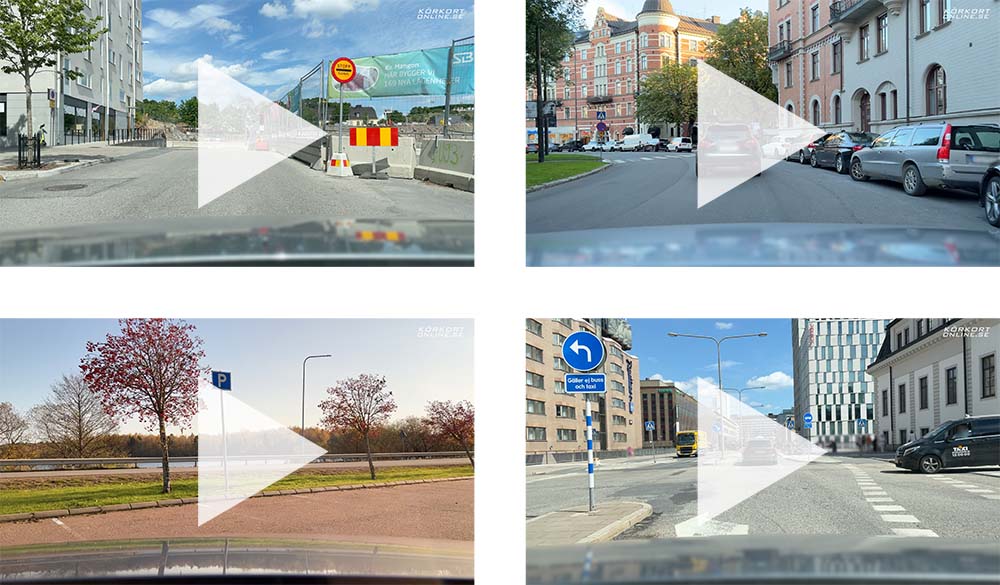Lanes – placement & changing lanes
Different types of lanes
Lanes can take two different forms:
- Marked: The lanes are separated by lines. This is the most common type.
- Unmarked: If there is enough room to drive a four-wheeled vehicle, this is also considered to be a lane.
Positioning of the car inside the lane
The basic rule is that you should be in the middle of your lane. However, there are situations in which another position is more appropriate.
When approaching a wide oncoming vehicle, you can move to the right of your lane. However, pay close attention to pedestrians and obstacles along the right side of the road.
If you have good visibility ahead, but poor visibility to the sides (e.g. dense forest), you can move to the left of your lane. However, avoid this placement if there is oncoming traffic, or may suddenly be oncoming traffic (e.g. bends).

Both oncoming traffic and obstacles along the side of the road might be hidden around the bend. Slow down and stay in the middle of your lane.
When turning
- Left turn: As close to the left edge of your lane as possible. You must not hinder oncoming traffic.
- Right turn: As close to the right edge of the lane as possible.
When turning on a one-way road
On one-way roads you do not have to take oncoming traffic into consideration. The correct placement is therefore the following:
- Left turn: As close to the left edge of the lane as possible.
- Right turn: As close to the right edge of the carriageway as possible.
You are driving on a one-way road and want to turn left. Position your car to the left of the carriageway, as oncoming traffic is not allowed. Please note that the road you are about to enter is a regular road with two-way traffic (see the warning sign).
Which lane to choose
The basic rule is that you must choose the lane that is furthest to the right. However, if any of the following conditions are met, you may choose the lane that is most suitable for your continued journey:
- There are at least two marked lanes for traffic travelling in your direction, and the speed limit is 70 km/h or lower.
- The lanes lead to different destinations according to lane assignment signs.
You are driving towards Göteborg and have just overtaken another car. Unless you want to overtake more cars, you must change lanes to D. This is because the speed limit is 80 km/h and all lanes lead to the same destination. There will be an exit in 500 metres, but lane D continues straight ahead just like A, B and C.
Changing lanes
How to change lanes, step by step
- Check the traffic situation in front of you.
- If the distance to the vehicle in front of you is good, check:
- Rear-view mirror.
- Side mirror.
- Blind spot (turn your head).
- If everything looks good, turn on your indicator.
- Wait a few seconds. Keep your eyes moving and gauge the reactions of other road users.
- Check your blind spot one last time.
- Calmly turn into the new lane. A small speed increase is appropriate when changing lanes if there are vehicles close behind you in the new lane.
Prohibition on changing lanes
In dense traffic on roads with multiple lanes in your direction, there will sometimes be gaps in the other lanes. It may then be tempting to change lanes in order to move further ahead. However, you are not allowed to slalom between cars.

Example of unlawful slaloming.
You are not permitted to pass over into another lane if the line on your side is solid.

A is not permitted to pass over into B’s lane, as there is a solid centre line on A’s side. B, on the other hand, is allowed to move into A’s lane (for example when overtaking) as the line is not solid on B’s side.
Special lanes
Public transport lane (bus lane)
The purpose of public transport lanes is to ensure that buses do not get stuck in queues, which would delay them. Bicycles and class II mopeds (not EU mopeds class I) may also use a public transport lane located to the right in the direction of travel.
If any other vehicles are permitted to use the public transport lane, this is specified on an additional panel.
You may cross a public transport lane, for example if you are going from A to B:

Reversible lane
The direction of traffic flow in a reversible lane can be changed as needed. In the afternoon, many road users will be travelling home from work, and it is then practical to have an extra lane for traffic leaving the town centre. Reversible lanes are very rare.
Latest forum posts
- << Driving licence book online
- Lanes & placement ↑↑
- Priority rules >>





